The flower crab spider is one of 27 species of crab spider. The flower crab spider can alter the colour of its body to match its surroundings and to hide from prey. It is not as common as other types of crab spider.
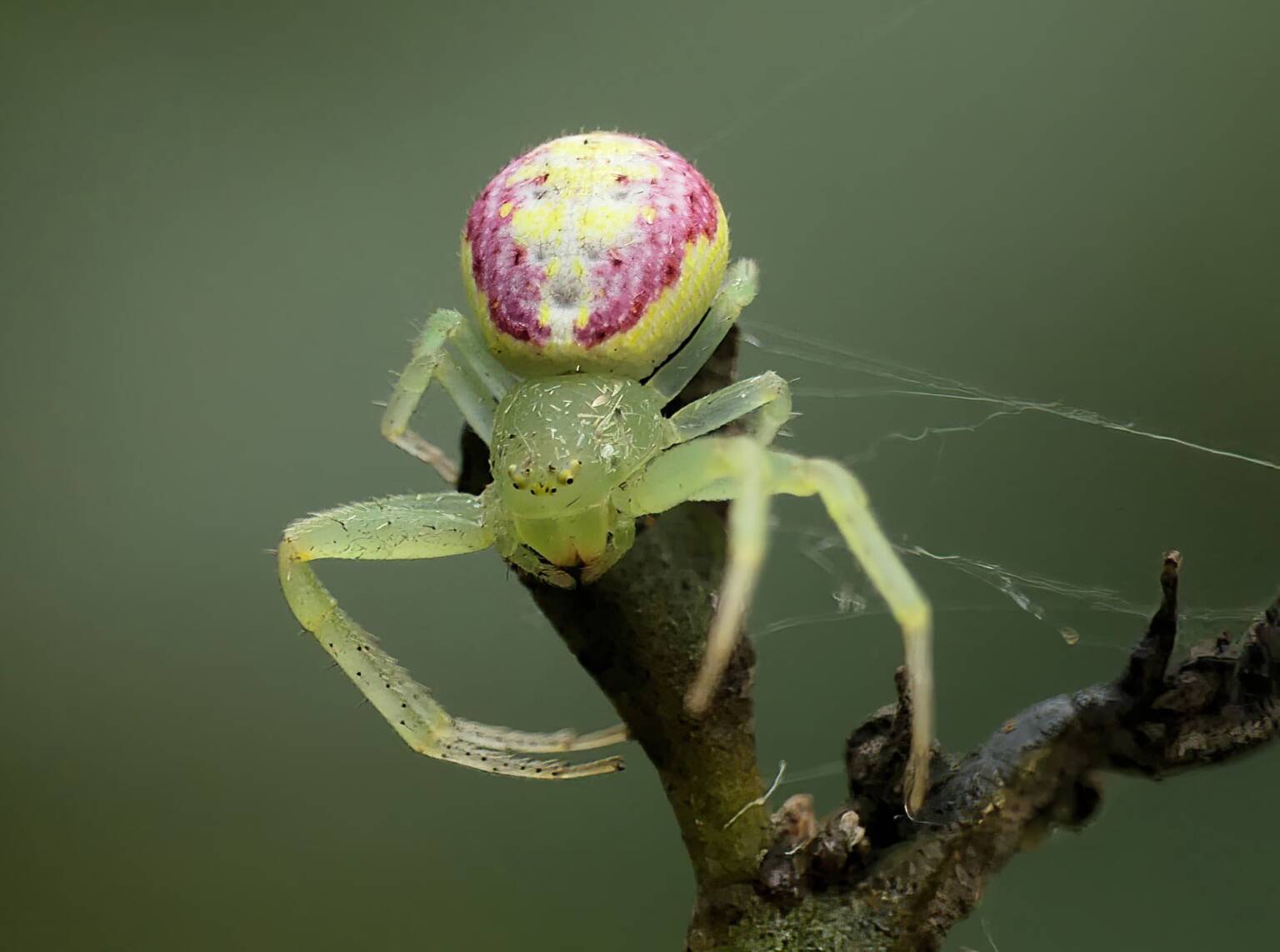
Flower spiders belong to the Family Thomisidae, one of the most colourful and attractive spider families. Despite the fact they are common throughout much of southern and eastern Australia, they are often so well camouflaged that the casual observer rarely sees them.
About
Unlike many spiders, flower crab spiders don’t spin webs to trap insects. Instead they ambush their prey, often laying in wait on foliage for unsuspecting bees, moths and other insects that come to feed on flowers. The male is smaller than the female and, unlike the female, cannot change their colouration.
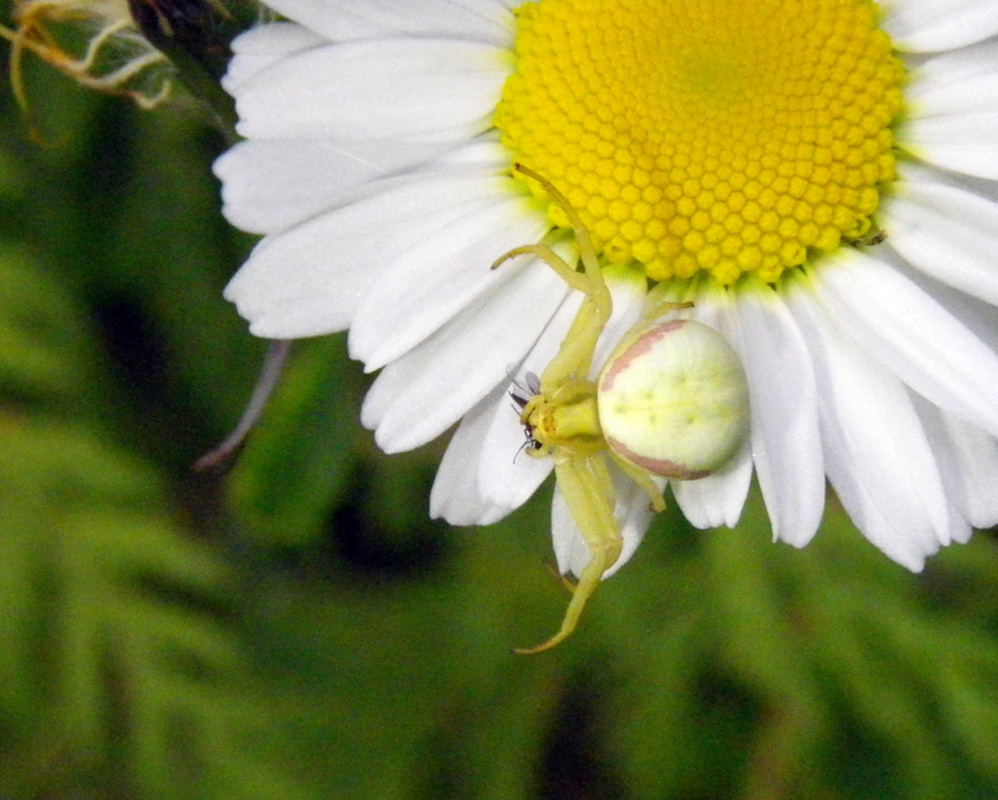
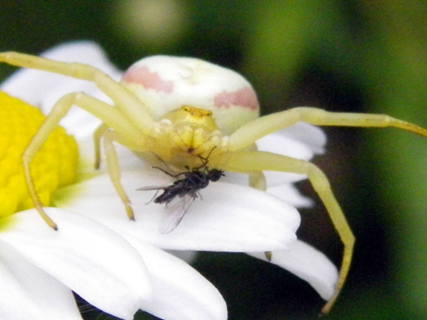
Identification
The goldenrod crab spider holds is legs out at its sides like a crab. The front two pairs of legs are longer than the back two. While both sexes can vary in colour — and individuals can alter their colouring for camouflage — each has a general colouring that is quite distinct from the other. The female tends to be yellow or light green to white with pale legs, a reddish streak along each side, and a reddish-brown spot between the eyes. The male has a similar abdomen (white with two central reddish bands) and a dark reddish-brown cephalothorax, marked by a white spot in the centre and another front of the eyes. The front two leg pairs are dark reddish-brown and longer than the back two yellowish pairs.
Habitat & Range
The goldenrod spider is often found camouflaged on daisies, goldenrod, other white or yellow flowers, and also leaves, in open habitats such as meadows, grasslands, fields, gardens, and wetlands. It is most commonly spotted in summer, when flower pollinators (upon which it preys) are abundant. It is a common crab spider, and its range extends across North America, Europe, and northern Asia.
Similar Species
The smaller and less common Misumenops asperatus is light grey to brownish with pink streaks on the abdomen and pink stripes on the cephalothorax, and is covered in short stiff hairs.
Intriguing Info
This spider does not weave webs to trap its prey; instead it sits on flowers and waits for pollinators to come to it, at which point it attacks.
How to identify
The flower crab spider has a globular abdomen, sometimes with spots or lines. They can change their colour to match their surroundings but often appear white. Their front legs are longer and stronger than their back legs. Primarily daytime feeders, these spiders are easiest to spot outdoors between April and September.
Identification
The prettier Flower Spiders have smooth, glossy bodies with short, unequal legs and a wide, more or less shortened abdomen that is often strikingly coloured. They are usually small in size (males smaller than females) and their two front pairs of legs are much heavier, longer and strongly spined than the hind pairs of legs. All four pairs of legs curve forward in a crab-like fashion, giving the group their other common name, Crab Spiders.
Many other thomisid species, such as Stephanopis and Tharpyna, are not brightly coloured, relying instead on blacks, browns and whites to blend in with the stem, bark and leaf litter habitats they frequent.

Feeding and diet
Flower spiders are foliage and flower dwellers that depend on their camouflage and ability to keep still both for protection and to catch their prey. Although they frequently change their hunting sites they use a sit-and-wait strategy for catching food. Prey animals, notably honey bees, butterflies, flies and beetles, are grabbed by the spiders’ spiny front legs and immediately bitten on the head area. The venom acts quickly to subdue the prey, which is eaten at once. Venom and digestive juices liquefy the insect’s internal tissues, which the spider sucks up, leaving an empty but life-like husk.
Other behaviours and adaptations
Some flower spiders are the same colour as the petals of the flowers they occupy, – usually overall yellow or white in colour. This camouflage not only protects them from birds but also gives them a hiding place from which to ambush incoming insects. However, others have a brownish to green carapace and legs and an abdomen that is white or yellowish and variously patterned in red, brown or green. This patterning allows these spiders to blend in with leafy foliage or flowery backgrounds. Some species can undergo slow changes in colour in order to adjust better to their background.
Flower spiders are diurnal and are common on Australian native flowers such as grevilleas and wattles. They are territorial with only one spider occupying a flower, unless they are male and female come together for mating. The occupant will often sit on a flower until the petals wilt before moving onto another flower. At night flower spiders hide under the petals or leaves.
Other members of the thomisid family, called crab spiders (such as Stephanopis scabra), are less colourful. They live on bark where they are well camouflaged with their knobbly bodies and dull brown-black colours. Still others, such as Runcinia elongata, live among grassy herbage. Their russet coloured body blends with the grass seed heads on which they are often found.
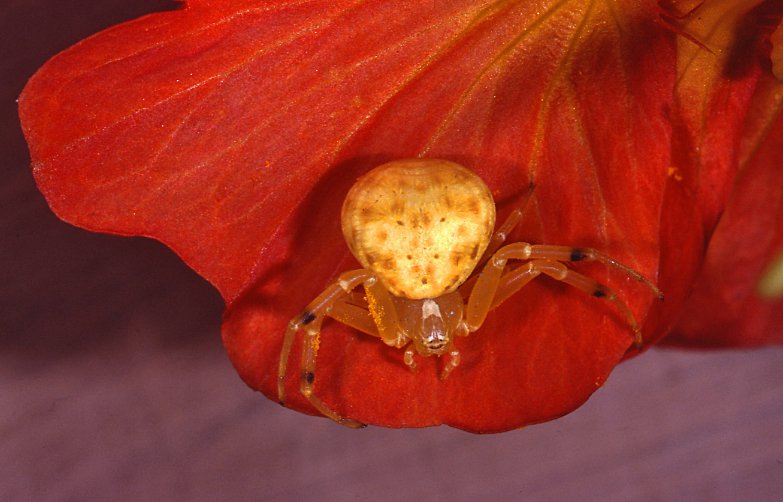
Life history cycle
After mating, a female flower spiders conceal and guard their woolly egg sacs within a leaf or grass blade shelter, sometimes folding the latter origami-like into a little box-like retreat, and she will provide her developing young with insects. Sometimes she may be eaten too, especially if food is scarce.
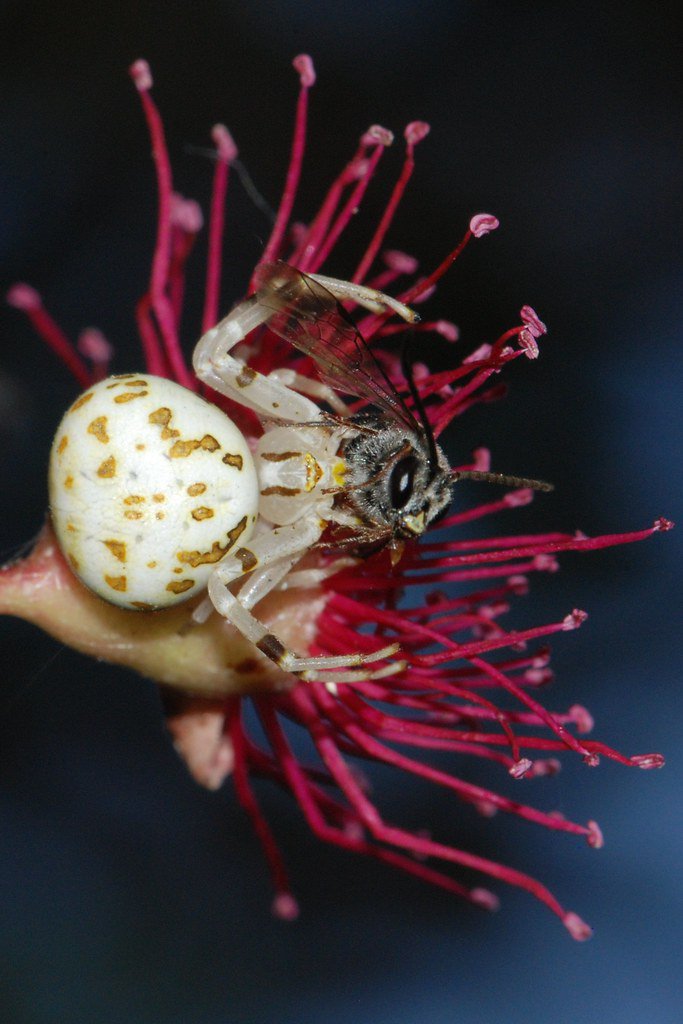
In southern Australia, Australomisidia (previously Diaea) are social spiders. They weave a ball-shaped communal nest out of slender eucalypt leaves. These spiders are comparatively large (7-9mm females) and lack the bright colours typical of other Australomisidia species. The females migrate from their parental nests after mating, and construct their own nest, beginning with a single coiled leaf. After four or five leaves are added, a single egg sac is constructed and about 45 eggs are laid. The mother then continues to build the nest and to provide her young with large prey items such as beetles and wasps. The young develop during winter and spring, and sometimes help the mother to build up the nest further. However, they will eventually eat their mother if food becomes scarce. During the summer months the males mature first, migrating to find other nests. The females mate within their parental nest before their own migration.
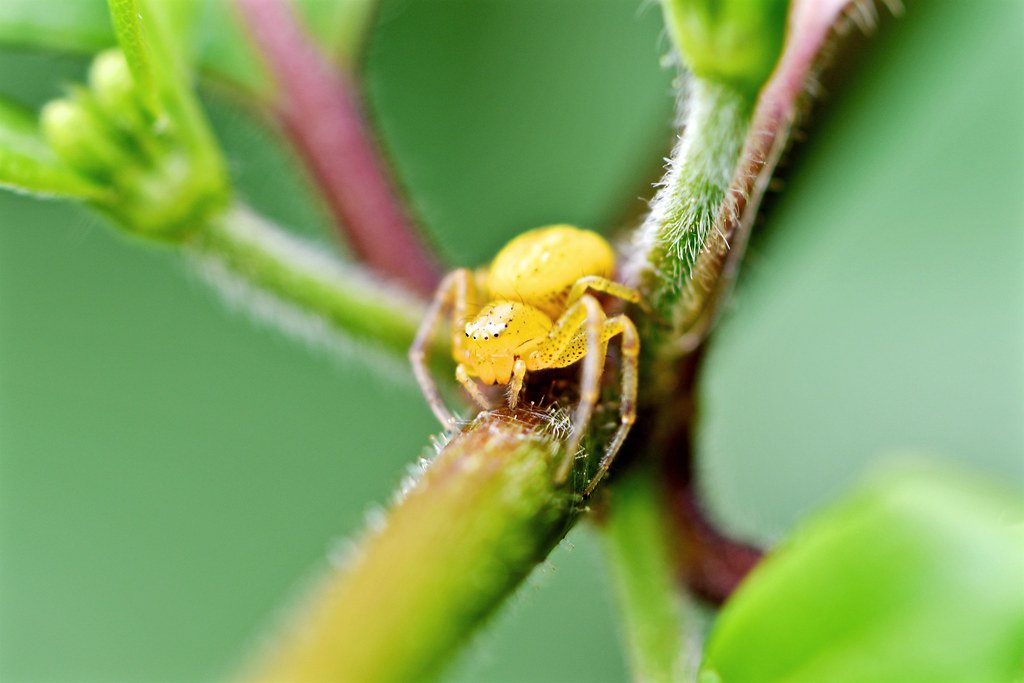
Flower Spider/Crab Spider
Introduction:
The Flower Spider’s Latin name is Thomisus spectabilis. Another name for the Flower Spider is the Crab Spider because it has white or yellow stout legs which are held like a crab. The full size of the Flower Spider is between four and ten millimetres. Flower Spiders are often white or yellow in colour, some have green, brown or rosy tints on the abdomen. The females are small and their legs are less than 7mm long. The males are even smaller, but their legs are longer. They normally have two large front eyes and have very well developed eyesight.
Habitat:
Each Flower Spiders takes a flower as its hunting territory and waits on the petals, anchored by its hind legs and pedipalps extended. An insect visiting the flower for pollen or nectar is seized and bitten, then sucked dry. They are mostly common in Summer and are Australia wide. They also live in the garden on native flowers, on grass heads and among seed pods and in rushes. They are common on native flowers such as Grevillea. Flower spiders are diurnal in their habits which means they are active in the day time.
Prey:
Flower Spiders feed eat insects such as butterflies and nectar feeding insects. They even eat bees as you can see from the picture below. The Flower Spider catches insects with its front legs which close together like a pair of tongs. It also jumps at the insect which lands on the flower, then eats it.
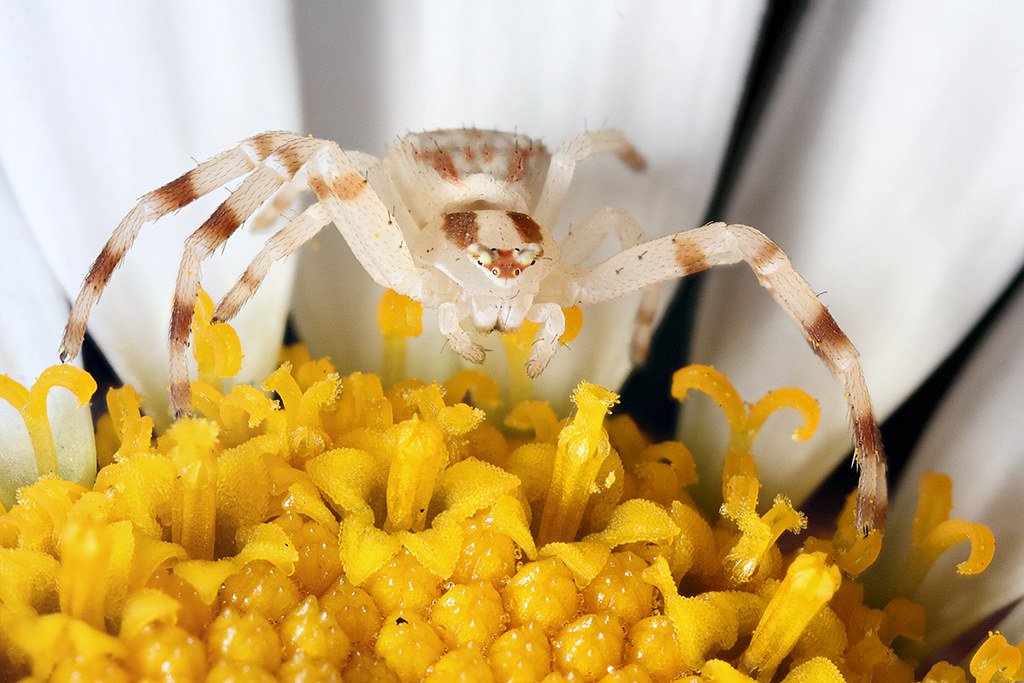
Breeding:
When the female is ready to lay her eggs, she weaves a tiny silk dish, then she lays her eggs in the tiny dish. Then she makes a silk lid to fit the dish and that is her egg sac. The eggs are like tiny green jewels that stay in the egg sac up to two weeks. When the spiderlings hatch, they are left to fend for themselves.
Venom:Flower Spiders are quite quick to bite but only cause mild local pain to humans.
One species of Crab Spider is the Goldenrod Spider It is best known for its ability to change its colour from white to yellow in order to camouflage among flowers. The female is the one most often seen. She is either yellow or white, depending on where she is, with red streaks on her abdomen. The male is dark reddish-brown, with a whitish abdomen with dark red streaks. The male is smaller (about 1/8 inch) than the female (up to 3/8 inch). Goldenrod Spiders are found wherever there are yellow and white flowers, especially goldenrod and daisies. This is usually in a field or garden.
